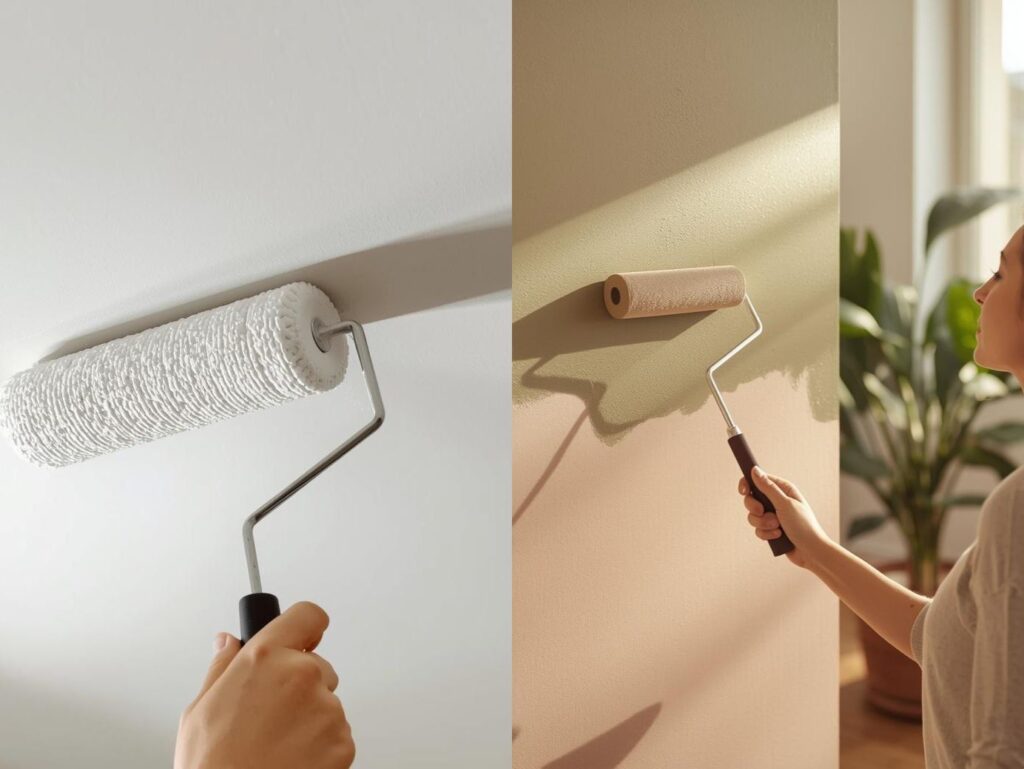
If you’ve ever wondered why your walls look streaky or why your ceiling seems a little off, buckle up. Because today, we’re unpacking all the ceiling vs wall paint secrets no one told you about from how they’re made to which one’s actually worth the money.
Ever walked into a freshly painted room and thought, “Wow, this feels brighter, taller, calmer somehow…”?
Yeah, that magic isn’t just about color. It’s about the difference between ceiling paint and wall paint, a tiny detail most people overlook but pros swear by.
If you’ve ever stood under a half-painted ceiling wondering why it’s raining white dots, here’s your quick fix. Ceiling paint is thicker, flatter, and made to hide imperfections while resisting drips. Wall paint, on the other hand, is tougher, smoother, and built to handle fingerprints, scrubbing, and sunlight. You can swap them in a pinch, but you’ll trade off either coverage or durability.
- Ceiling Paint: What It’s Really Made For
- Wall Paint: Built for Looks and Life
- Ceiling vs Wall Paint: Quick Comparison
- Color Options: What You Can Actually Choose
- Dry Time: Ceiling vs Wall Paint
- How to Paint a Ceiling
- How to Paint Walls Like a Pro
- Tools, Techniques, and Ergonomic Hacks
- Cost Breakdown: Ceiling Paint
- Cost Breakdown: Wall Paint
- Cost Comparison: Ceiling vs Wall Paint
- Maintenance and Lifespan: How Long Paints Actually Last
- Can You Use Ceiling Paint on Walls (and Vice Versa)?
- So, Which Is Better: Ceiling or Wall Paint?
- FAQs
Ceiling Paint: What It’s Really Made For
Ceiling paint isn’t just “white paint.” It’s a formula with a mission to hide imperfections, diffuse light, and stay put overhead without dripping in your hair. The science behind it is simple but smart. Ceiling paint has a higher viscosity, meaning it’s thicker and less likely to splatter. That gives you smooth, streak-free coverage, especially when you’re rolling it above your head.
Most professional painters stick to a flat or matte finish because it hides bumps, nail marks, and patchwork beautifully. A shiny ceiling reflects every flaw, something you definitely don’t want. Flat ceiling paint absorbs light evenly, making the room look calm, cohesive, and softly diffused.
Pro tip: Always go for flat or matte ceiling paint. Glossy finishes will highlight every dent and roller mark like a neon sign.
Wall Paint: Built for Looks and Life
Wall paint, on the other hand, is your extrovert. It’s meant to show off.
You can scrub it, wash it, and still have it looking good years later. It comes in endless finishes: matte, satin, eggshell, even semi-gloss depending on the vibe you’re going for.
Wall paint also has more resins and pigments, which means it’s richer in color and more durable. Whether it’s your cozy bedroom or the high-traffic hallway, wall paint is built to take a few hits (and still look stunning).
The biggest difference? Wall paint enhances texture and depth, while ceiling paint aims to vanish. Wall paint catches light, brings warmth, and becomes part of your home’s personality.
Pro tip: For most homes, an eggshell or satin finish strikes the perfect balance between beauty and practicality.
Ceiling vs Wall Paint: Quick Comparison
| Feature | Ceiling Paint | Wall Paint |
| Finish | Flat / Matte | Matte, Satin, Eggshell, Semi-gloss |
| Texture | Thick, hides flaws | Smooth, rich finish |
| Durability | Moderate | High |
| Purpose | Hides imperfections, diffuses light | Decorative, washable, long-lasting |
| Color Range | Mostly white / off-white | Thousands of shades |
| Dry Time | 1–2 hours | 2–4 hours |
| Price Range | Budget-friendly | Moderate to premium |
Color Options: What You Can Actually Choose
Ceiling paints usually come in white or soft neutrals, think cloud white, ivory, or pale gray.
And there’s a reason for that: lighter shades reflect light and make rooms feel bigger.
Wall paints, however, are where your personality shines. From deep charcoal to sage green or sunset blush, you can experiment endlessly. You can even use color to trick the eye darker walls can make ceilings feel taller and rooms cozier.
Dry Time: Ceiling vs Wall Paint
If patience isn’t your thing, you’ll love ceiling paint. It dries in about 1–2 hours.
Wall paint, though, takes a bit longer (2–4 hours) because of its thicker resins and richer pigments. And if you’re going for glossy or darker tones, expect to wait a little more before that second coat.
How to Paint a Ceiling
Here’s what pros do and you can too:
- Move or cover furniture with plastic sheets.
- Tape the wall edges where the ceiling meets the wall.
- Use a primer if it’s your first coat or a stained ceiling.
- Go for a flat white ceiling paint.
- Use an extension roller and roll in one direction to avoid lap lines.
- Apply two thin coats instead of one heavy layer.
Bonus tip: Starting early in the day natural light helps spot missed areas.
How to Paint Walls Like a Pro
- Wipe walls clean (a damp cloth works wonders).
- Lightly sand if old paint is flaky.
- Tape around trims and outlets.
- Apply primer (especially if switching from dark to light shades).
- Use a roller in a W-pattern for even coverage.
- Apply two coats and let it fully dry between each.
Pro tip: Avoid painting under harsh light shadows can make even coverage harder to spot.
Tools, Techniques, and Ergonomic Hacks
Painting overhead isn’t easy. A few small tweaks can save you from a sore neck (and a paint-speckled face).
Use a ⅜” to ½” roller nap for ceilings it holds more paint and distributes it evenly. Always attach your roller to an extension pole; you’ll get cleaner coverage and better control. And never skip protective gear. Goggles, gloves, and even a hat are small things that make a big difference.
If you’re painting a large ceiling, compare rollers to sprayers. Rollers are beginner-friendly, but sprayers cover faster with a smoother finish if you can manage the setup and cleanup.
Cost Breakdown: Ceiling Paint
Ceiling paint is one of the most affordable upgrades you can do.
- DIY Cost: $20–$60 per gallon (covers ~350 sq. ft.)
- Professional Cost: $1.25–$2.50 per sq. ft.
Because you usually use just one color and finish, it’s lighter on the wallet and quicker to complete.
Cost Breakdown: Wall Paint
Wall paint costs more, but for good reason.
- DIY Cost: $30–$80 per gallon (depending on sheen and brand)
- Professional Cost: $2–$4.50 per sq. ft.
Finishes, color layers, and prep work all add to the total but the result lasts longer and looks richer.
Cost Comparison: Ceiling vs Wall Paint
| Category | Ceiling Paint | Wall Paint |
| DIY Cost | $20–$60/gallon | $30–$80/gallon |
| Pro Labor Cost | $1.25–$2.50/sq. ft. | $2–$4.50/sq. ft. |
| Dry Time | 1–2 hours | 2–4 hours |
| Overall Expense | More budget-friendly | More expensive |
Maintenance and Lifespan: How Long Paints Actually Last
Most homeowners repaint walls every three to five years, depending on wear. Ceilings can go seven to ten years before needing a refresh. But if your ceiling shows yellowing, cracks, or water stains, it’s time to repaint sooner.
In high-humidity rooms like bathrooms or kitchens, that lifespan drops fast. Keep a simple rule: when walls start looking tired, your ceiling’s not far behind.
Can You Use Ceiling Paint on Walls (and Vice Versa)?
You can… but you probably shouldn’t.
Here’s the truth:
- Ceiling paint on walls – It’s too chalky. The texture feels flat and dull, and it’s not washable. Every time you brush past the wall, it’ll leave marks.
- Wall paint on ceilings – Big mistake. Wall paint is heavier, drippier, and more reflective. You’ll end up with streaks, drips, and every ceiling flaw suddenly glowing under the light.
Both are engineered differently for a reason. Ceiling paint hides flaws; wall paint enhances beauty. Mixing them up usually leads to a “Pinterest fail” moment.
So, Which Is Better: Ceiling or Wall Paint?
Honestly? It depends on your goal.
If you want a seamless, soft ceiling that hides imperfections, go with ceiling paint. It’s made for that. But if you want durable, colorful, and easy-to-clean walls, wall paint wins every time.
The biggest mistake homeowners make is interchanging the two. Ceiling paint on walls looks flat and lifeless, while wall paint on ceilings drips and highlights every flaw. The real secret isn’t choosing one, it’s knowing how to use both together for a professional, cohesive look.
FAQs
Why is ceiling paint cheaper?
It’s simpler, with fewer resins, no fancy finish, and made for one purpose: coverage.
What sheen hides imperfections best?
Flat or matte finishes. Always.
Is low-VOC paint worth it?
Absolutely. It improves air quality and reduces odor, especially important in bedrooms or nurseries.
How many coats of ceiling paint do I need?
Usually one to two. If there are stains or color changes, prime first.



